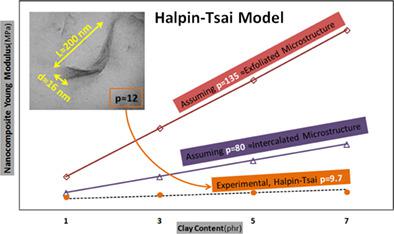当前位置:
X-MOL 学术
›
J. Vinyl Addit. Technol.
›
论文详情
Our official English website, www.x-mol.net, welcomes your feedback! (Note: you will need to create a separate account there.)
Dispersion state and hyperelastic behavior of tire tread compounds reinforced with nanoclay: Uniaxial tensile and compression studies
Journal of Vinyl and Additive Technology ( IF 2.7 ) Pub Date : 2021-05-19 , DOI: 10.1002/vnl.21830 Shirin Shokoohi 1 , Ghasem Naderi 2
Journal of Vinyl and Additive Technology ( IF 2.7 ) Pub Date : 2021-05-19 , DOI: 10.1002/vnl.21830 Shirin Shokoohi 1 , Ghasem Naderi 2
Affiliation

|
Tire-tread compounds based on natural rubber, butadiene rubber, and styrene-butadiene rubber (65/20/15) were reinforced with Cloisite 15A. Clay state-of-dispersion in the ternary matrix (clay aspect ratio and clay/matrix interface yield strength) was estimated using Halpin–Tsai, Guth, and Leidner–Woodhams–Pukanszky micro-mechanical models. The aspect ratio suggested by Halpin–Tsai (9.7) and Guth (16) models both propounded partially intercalated microstructure. Transmission electron microscopy micrographs indicated higher reliability of Halpin–Tsai theory. Wetting parameter values indicated the affinity of Cloisite 15A to disperse in butadiene rubber. However, it seems that clay particles were not provided with proper compounding conditions to further stabilize their thermodynamic state. The poor matrix/clay adhesion was responsible for the decrease in matrix/clay interface strength and thickness upon increasing clay content according to Leidner–Woodhams–Pukanszky. Hyperelastic modeling was conducted using Abaqus software (five strain energy potential forms) on the basis of large deformation uniaxial tension/compression measurements. Effect of nanoclay on the crosslink-density of samples was justified by C10 (Mooney–Rivlin) and locking-stretch (Van der Waals) values. The sample containing 1 phr nanoclay presented the best fit to the hyperelastic models among the rest conforming to its small value of global interaction parameter “a”(Van der Waals model) calculated explaining minimum deviations. Overall, Marlow and Ogden provided the best consistency with the experimental stress–strain results.
中文翻译:

纳米粘土增强轮胎胎面胶的分散状态和超弹性行为:单轴拉伸和压缩研究
基于天然橡胶、丁二烯橡胶和丁苯橡胶 (65/20/15) 的轮胎胎面胶料用 Cloisite 15A 增强。粘土在三元基质中的分散状态(粘土纵横比和粘土/基质界面屈服强度)使用 Halpin-Tsai、Guth 和 Leidner-Woodhams-Pukanszky 微机械模型进行估计。Halpin-Tsai (9.7) 和 Guth (16) 模型建议的纵横比都提出了部分插入的微观结构。透射电子显微镜显微照片表明 Halpin-Tsai 理论的可靠性更高。润湿参数值表明Cloisite 15A 分散在丁二烯橡胶中的亲合力。然而,似乎没有为粘土颗粒提供适当的混合条件来进一步稳定它们的热力学状态。根据 Leidner-Woodhams-Pukanszky 的说法,基质/粘土粘附性差是增加粘土含量后基质/粘土界面强度和厚度降低的原因。基于大变形单轴拉伸/压缩测量,使用 Abaqus 软件(五种应变能势形式)进行超弹性建模。纳米粘土对样品交联密度的影响由 C 证明10 (Mooney–Rivlin) 和锁定拉伸 (Van der Waals) 值。含有 1 phr 纳米粘土的样品最适合超弹性模型,其余部分符合其计算的解释最小偏差的全局相互作用参数“a”(范德华模型)的小值。总体而言,Marlow 和 Ogden 提供了与实验应力-应变结果的最佳一致性。
更新日期:2021-05-19
中文翻译:

纳米粘土增强轮胎胎面胶的分散状态和超弹性行为:单轴拉伸和压缩研究
基于天然橡胶、丁二烯橡胶和丁苯橡胶 (65/20/15) 的轮胎胎面胶料用 Cloisite 15A 增强。粘土在三元基质中的分散状态(粘土纵横比和粘土/基质界面屈服强度)使用 Halpin-Tsai、Guth 和 Leidner-Woodhams-Pukanszky 微机械模型进行估计。Halpin-Tsai (9.7) 和 Guth (16) 模型建议的纵横比都提出了部分插入的微观结构。透射电子显微镜显微照片表明 Halpin-Tsai 理论的可靠性更高。润湿参数值表明Cloisite 15A 分散在丁二烯橡胶中的亲合力。然而,似乎没有为粘土颗粒提供适当的混合条件来进一步稳定它们的热力学状态。根据 Leidner-Woodhams-Pukanszky 的说法,基质/粘土粘附性差是增加粘土含量后基质/粘土界面强度和厚度降低的原因。基于大变形单轴拉伸/压缩测量,使用 Abaqus 软件(五种应变能势形式)进行超弹性建模。纳米粘土对样品交联密度的影响由 C 证明10 (Mooney–Rivlin) 和锁定拉伸 (Van der Waals) 值。含有 1 phr 纳米粘土的样品最适合超弹性模型,其余部分符合其计算的解释最小偏差的全局相互作用参数“a”(范德华模型)的小值。总体而言,Marlow 和 Ogden 提供了与实验应力-应变结果的最佳一致性。



























 京公网安备 11010802027423号
京公网安备 11010802027423号